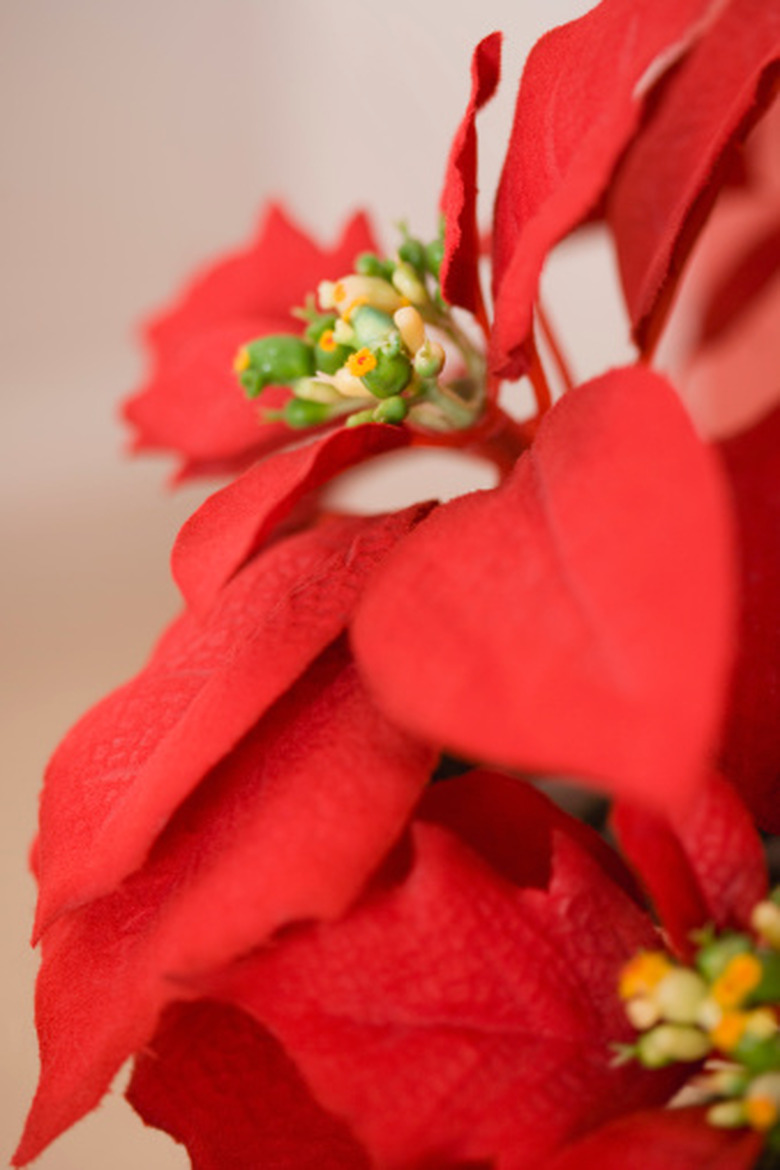How To Trim Poinsettias
Poinsettia plants don't require very much water and in some U.S. climates can survive winter outdoors, though in most place these southern Mexico natives are enjoyed as holiday houseplants. Poinsettias need pruning attention throughout the year. For healthy, bright red flowers — actually modified flower petal-like leaves — and thick, green leaves, trim your plant throughout the year. Snipping off diseased leaves and managing larger stalks help promote better overall poinsettia health.
Step 1
During the spring and summertime, poinsettia plants are susceptible to mildew growth. Mildew-damaged leaves rarely recover, so snip them off at their bases to prevent spreading. Mildew appears as powdery or fuzzy white spots. Poinsettia plants feature particularly dense leaf structures, so it's important to catch mildew spots before they spread through the close structure. Fungicide can help prevent future mildew outbreaks.
- Poinsettia plants don't require very much water and in some U.S. climates can survive winter outdoors, though in most place these southern Mexico natives are enjoyed as holiday houseplants.
- Poinsettia plants feature particularly dense leaf structures, so it's important to catch mildew spots before they spread through the close structure.
Step 2
Cut out damaged branches at a 45-degree angle during winter. Poinsettias remain active in winter, and flowers may even develop while snow is still on the ground in mid to late winter. Pruning off snow-damaged branches helps the plant retain crucial nutrients as it undergoes wintertime growth.
Step 3
Trim periodically during winter and spring flowering season, maintaining 2-foot stalks. Poinsettia bud growth and flowering diminishes when stalks extend beyond 2-foot maturity.
Step 4
Deadhead in late spring to promote new bud growth for next season. Dead flowers will lose their color and wilt. These sickly flowers continue to suck nutrients from the plant as they die, so remove them once late-spring wilting begins.
- Cut out damaged branches at a 45-degree angle during winter.
- Poinsettias remain active in winter, and flowers may even develop while snow is still on the ground in mid to late winter.
Step 5
Prune the plant heavily at the end of the growing season, once all the dead flowers are removed. So-called "hard cutting" is beneficial for many perennial plants. To promote active regrowth, the "Pruning Handbook" recommends leaving only two or three poinsettia buds intact after the flowers have died .
Plant Poinsettias
Keep your poinsettia in a warm, well-ventilated room following the holidays and water it anytime the soil feels dry after the leaves begin to drop. Trim the old branches and flowering shoots back to 4 to 6 inches with pruning shears when the poinsettia begins to grow side shoots in late February or early March. Leave at least one leaf on each branch. Fertilize the poinsettia plant with a water-soluble, indoor plant fertilizer every two weeks according to manufacturer instructions. Dig a hole in a well-drained area of your garden with full sun in the morning and partial afternoon shade. Fill in around the hole just up to the rim of the container. Dig up the poinsettia container during the first week of October, and place the plant in a completely dark area, such as a closet or garage, that has a temperature between 60 and 70 degrees Fahrenheit from 5 p.m. to 8 a.m. each night until late November or early December, when color begins to show.
- Prune the plant heavily at the end of the growing season, once all the dead flowers are removed.
Things Needed
- Pruning shears
- General purpose fungicide
References
- "Simon and Schuster's Complete Guide to Plants & Flowers"; Frances Perry; 1976
- "Pruning Handbook"; John K. McClements and Philip Edinger; 1990
- "Pests and Diseases"; Andrew Halstead and Beatrice Henricot; 2010
- Ohio State University Extension: Poinsettia Care in the Home
- Aggie Horticulture: Poinsettia
- Michigan State University Extension: Poinsettias
- The Weather Channel: Average Weather for San Francisco
